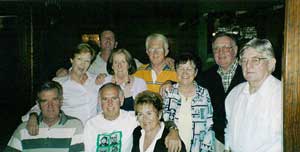16 December 2004 Edition
Bogtrotters follow Michael Dwyer Down Under

The Clerys with members of Australian Aid for Ireland
Bogtrotters Gay and Sinéad Clery recently travelled to Sydney, Australia, to visit relatives, but they also found time to visit the final resting place of that giant of the United Irishman period, Michael Dwyer. Here, GAY CLERY examines Dwyer's legacy.
Michael Dwyer was born in the Glen of Imaal in Wicklow in 1772, in the townland of Camara at the foot of the mighty Lugnaquillia Mountain.
He came from a farming background and was educated in the townland of Ballyhubbock. He joined the United Irishmen in 1797 and fought in a number of battles in Counties Wexford and Wicklow. He returned to Imaal and became leader of the last group of "outstanding rebels" after the autumn of 1798, marrying Mary Doyle on 16 October that year.
Dwyer had many adventures and escapes over the following years and was the only one to escape from Derrynamuck on 15 February 1799. His group was surprised as they slept in three different cottages. Three men were killed at the site, eight were captured, seven were later executed, and one turned. 500 Guineas reward was offered for Dwyer's capture. The official description read: Straight of back, five foot nine inches tall, short neck, square shouldered, black hair, long legged.
After the Robert Emmet uprising in the summer of 1803, Dwyer and his remaining comrades came under severe pressure. Most of their family and friends were imprisoned and "free quarters" was established in any area where they were known to have supporters. Free quarters meant troops were forcibly billeted upon the populace in an effort to quiet the country and recover arms. Floggings, house burnings and torture often accompanied free quarters. By this stage, the hope of a French landing was gone and the military was carrying out massive sweeps across the mountains.
A severe winter was setting in and on 14 December 1803, Dwyer made his way down to the "Three Bridges" and agreed to the terms offered.
He was held in Kilmainham jail until July 1805. He was then transferred to the naval cutter Camden in Dublin bay. The Camden sailed to Cork and he was transferred to the Tellicherry along with his ever faithful wife, two of his children and his comrades, John Mernagh, Hugh Byrne, Martin Burke, Arthur Devlin and some of their family members.
They arrived at Port Jackson (Sydney harbour) on 18 February 1806.
Over the following years many more troubles and adventures lay ahead for Michael Dwyer and his family.
Michael Dwyer died on 23 August 1825, aged 53 years. The cause of death is believed to have been dysentery. He was survived by his wife and seven children. Mary Dwyer died in February 1861 and was buried in the same grave in Redfern Cemetery.
Later, because of the expansion of the town of Sydney, their bodies were moved to Waverly Cemetery, where they now rest together beneath a very noble monument erected to commemorate the heroes of '98.
And this is where our two Bogtrotters, Sinéad and Gay Clery, headed for soon after arriving in Sydney. Accompanied by our "found again" families and following directions from Paddy O'Gorman and Peter Lynch, we reached this lovely spot high above the Tasman Sea. We would have lingered longer here to admire this fine monument if it wasn't for the heavy rain (would you believe) that sent us scurrying back to the cars.
From here, we headed off to meet up with historian Shay O'Hara at Vinegar Hill.
He told of the tale of how, in the month of March 2004, rebellion erupted at Castle Hill in Western Sydney. The rebels' aim was to advance on Sydney, commandeer ships and sail back to Ireland. This rebel force consisted for the most part of United Irishmen transported after '98 and their rallying cry was "Death or Liberty".
The military and rebels faced each other at what is now called Vinegar Hill. While negotiations were going on under a flag of truce, the soldiers attacked the poorly armed rebels. About 20 were killed and later nine leaders were executed.
A fine monument depicts the 200-year history of Australia, including the battle fought on the spot.
The next day we trotted off to Adelaide in South Australia, to meet up with our grandchildren and we later enjoyed many excursions to the surrounding hills and beaches. We also had the pleasure of meeting up with the Adelaide AAI (Australian Aid for Ireland) group and many thanks to all concerned for a most memorable and enjoyable evening.
